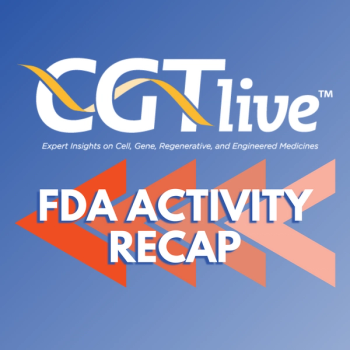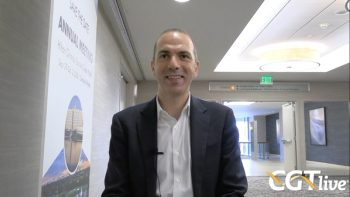
Tandem CD20/CD19 CAR Zamto-Cel Shows Promise in DLBCL
Zamtocabtagene autoleucel showed promising early complete response rates and survival outcomes in patients with relapsed/refractory diffuse large B-cell lymphoma.
The tandem CD20/CD19 targeted non-cryopreserved CAR T-cell therapy zamtocabtagene autoleucel (zamto-cel) showed promising early complete response (CR) rates and survival outcomes in patients with relapsed/refractory diffuse large B-cell lymphoma (DLBCL), according to interim findings from the pivotal phase 2 DALY II USA study (NCT04792489) presented at
In the preplanned interim findings from phase 2 study, the overall response rate (ORR) was 72.8% and the complete remission (CR) rate was 50.8%. The median duration of response was 11.4 months for those with an ORR and was not yet reached for those with a CR. The median progression-free survival (PFS) was 9.0 months and the PFS rate was 55% (95% CI, 41%-67%). The median overall survival was not reached at the interim analysis.
"We are excited to share a unique platform with our tandem cell therapy. This is the first tandem CD20/CD19 CAR T-cell product delivered as a fresh infusion,"
Zamto-cel utilizes a 4-1BB co-stimulatory domain with dual targeting domains for CD19 and CD20. The manufacturing process uses CliniMACS Prodigy at the point of care and includes apheresis, T cell separation, activation, transduction, and then expansion. After this point, the cells are infused without the need for cryopreservation. The vein-to-vein time was 12 to 14 days.
READ MORE:
"There is no cryopreservation indicated for this product, it allows for a true vein-to-vein time of 14 days," said Shah. "This platform really allows rapid delivery. You don't need bridging therapies and consistent with that no patients died while waiting."
Overall, 104 patients were screened, 74 were apheresed, and 69 received treatment with zamto-cel. Of these, 10 patients were not evaluable at the time of the interim analysis, leaving a modified intent-to-treat group of 59.
The median age of patients across the full group (n = 69) was 65 years. Roughly half had an elevated LDH (55.1%) and 53.6% had 2 or more extranodal sites. The median number of prior lines of therapy was 2 for most (75.4%), with the remainder of patients having received 3 or more. A quarter of patients had a prior autologous stem cell transplant (24.6%) and few received bridging therapy, specifically 3 who received steroids and 1 who received radiotherapy. The most delivered lymphodepletion therapy was fludarabine/cyclophosphamide (90%) with 10% of patients receiving bendamustine.
Of the 69 patients enrolled, the cell therapy was successfully manufactured according to product specifications 91.3% of the time. The viability of the cells collected was a median of 96%, the transduction efficiency was 28%, and the median vector copy number was 1.33.
There was a low incidence of cytokine release syndrome (CRS) and immune effector cell-associated neurotoxicity syndrome (ICANS). There were no cases of grade 3 or higher CRS and 4.3% of patients had grade 3 or higher ICANS. Grade 1/2 CRS was seen in 46.4% and grade 1/2 ICANS was experienced by 17.3%. Treatments for CRS/ICANS were given to 34 patients, most commonly steroids (n = 10), Anakinra (n = 2), and tocilizumab (n = 11).
Grade 3 or higher hematologic toxicities were experienced by 62.3% of patients treated with zamto-cel, which consisted of neutropenia/neutrophil count decline (47.8%), anemia/hemoglobin decrease (20.3%), and thrombocytopenia/platelet count decline (11.6%). Grade 3 or higher infections were seen in 4.3% of patients and deaths due to any cause were reported for 5 patients, 3 were due to disease progression, 1 from sepsis, 1 from intestinal perforation, and 1 from COVID-19 pneumonia. There were no cases of secondary malignancies reported.
Upon inspection, antigen loss did not appear to be a driver of progression. Overall, there was no loss of target antigen seen in 82% of patients who progressed. Loss of CD19 alone was seen in 7% of patients, loss of CD20 was seen in 7% of patients, and 1 patient (4%) experienced dual CD19 and CD20 loss. Overall, the CAR T cells were found to proliferate while B cells recovered.
"We need to continue to biopsy people and also to understand what is that mechanism of resistance to this dual-targeted CAR T cell product," said Shah. "We see the preclinical data playing out with the CAR T expansion kinetics. We start to see recovery of B cells, which is important for patients to have immune reconstitution."
For more coverage of ASH 2024,
Reference
Shah NN, Maziarz RT, Jacobson CA, et al. Interim Results from a Phase 2 Pivotal Study (DALY II USA) of Tandem CD20-CD19-Directed Non-Cryopreserved CAR-T Cells - Zamtocabtagene Autoleucel (Zamto-Cel) in Patients with Relapsed/Refractory Diffuse Large B Cell Lymphoma. Presented at: ASH 2023 Annual Meeting & Exposition. December 7-10; San Diego, CA. Abstract #68.
Newsletter
Stay at the forefront of cutting-edge science with CGT—your direct line to expert insights, breakthrough data, and real-time coverage of the latest advancements in cell and gene therapy.










































